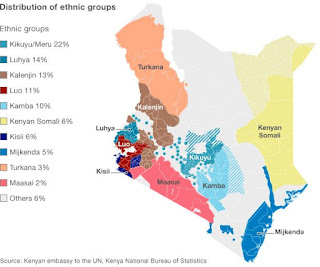HISTORY OF KENYA
THE CREATION THEORY
This history book chooses to expand on the
Adam and Eve story wherein we know that they reproduced and their children
moved in all sorts of directions from the Garden of Eden to the Congo forest
where the Bantus came from. They entered Kenya through a route in Western
Province and the Kurias and the Kisiis decided to settle at the border and
developed their own language.
The Luhyas, Kikuyus, Merus and Embus
proceeded eastwards and wherever they settled, they developed a new language.
We must admit that they were brain-boxes seeing that we have only managed to
develop Sheng which we have heavily borrowed from them anyway.
They settled around Mt. Kirinyaga. The Kambas proceeded to the Eastern side of the mountain, and were happy to inform the Europeans who will come in the following pages that the mountain was called Mt. Kiinyaa. The Europeans decided it had too many vowels and reduced it to Mt. Kenya from where we also get the name of our beloved country.
Aren’t we glad that they met around Mt. Kenya
and not Mt. Kilimanjaro? We do not even want to form a mental image of what a
tongue twister the name of our country would have become – Kiimanzalo probably, whose membership no international organization
would accept!
The creation story merges right here with the
evolution story because they both agree that the Kambas became long-distance
traders.
Meanwhile, the Nilotes who had settled in
Sudan heard that Kenya was a better place to live in and so they trickled
through the northern parts. The Turkana settled around Lake Turkana, the Luos
headed towards Lake Victoria; the Kalenjins moved eastwards and settled on the
highlands.
The Maasais claim that they fell from heaven
on a large bedsheet with millions of cattle and this history book chooses to
believe them because we are already bogged down with the origin story and we
really would want to move to other interesting stories, like the Cushites
coming down in boats on the Indian Ocean and giving birth to the Arabs who
later sold slaves to America and the Middle East.
Meanwhile, in Europe, there were Christians
who believed that all men should go back to Eden and wanted to take them back.
They had such names as Dr Ludwig Krapf and Dr Livingstone. They set up missions
at the coast only to succumb to mosquitoes. Fortunately for the rest of Kenya,
their disciples carried on with the Christian message and built schools and
hospitals.
Their cousins, who had not seen the light,
heard about a land where the sun shone throughout the year, unlike their
country where, if they got lucky it shone three days a year. They came down in
droves to tame the Kenyan wilderness and decided to live and work here even
though there was nothing for them to do. After enjoying many days of sunshine,
they decided to build a railway line. And so they raided India and dragged
Indians into forced labour in the East Africa Protectorate.
When news reached England that there was a
bunch of Europeans who wanted to build a railway line in East Africa, the
general reaction in Europe was to sit sipping tea in the three days of sunset
and ask, “What will the hominids do with a railway line anyway?” Another group
would echo “Leave those lunatics alone”. And so the railway line was christened
the Lunatic Express. When they saw the determination of the lunatics and
perceived that the railway might end up becoming something worthwhile, they
renamed it the Kenya- Uganda railway.

Comments
Post a Comment